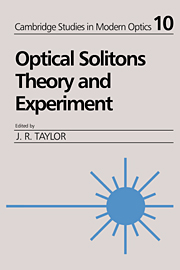Book contents
- Frontmatter
- Contents
- List of contributors
- Preface
- 1 Optical solitons in fibers: theoretical review
- 2 Solitons in optical fibers: an experimental account
- 3 All-optical long-distance soliton-based transmission systems
- 4 Non-linear propagation effects in optical fibres: numerical studies
- 5 Soliton–soliton interactions
- 6 Soliton amplification in erbium-doped fiber amplifiers and its application to soliton communication
- 7 Non-linear transformation of laser radiation and generation of Raman solitons in optical fibers
- 8 Generation and compression of femtosecond solitons in optical fibers
- 9 Optical fiber solitons in the presence of higher-order dispersion and birefringence
- 10 Dark optical solitons
- 11 Soliton-Raman effects
- Index
4 - Non-linear propagation effects in optical fibres: numerical studies
Published online by Cambridge University Press: 21 October 2009
- Frontmatter
- Contents
- List of contributors
- Preface
- 1 Optical solitons in fibers: theoretical review
- 2 Solitons in optical fibers: an experimental account
- 3 All-optical long-distance soliton-based transmission systems
- 4 Non-linear propagation effects in optical fibres: numerical studies
- 5 Soliton–soliton interactions
- 6 Soliton amplification in erbium-doped fiber amplifiers and its application to soliton communication
- 7 Non-linear transformation of laser radiation and generation of Raman solitons in optical fibers
- 8 Generation and compression of femtosecond solitons in optical fibers
- 9 Optical fiber solitons in the presence of higher-order dispersion and birefringence
- 10 Dark optical solitons
- 11 Soliton-Raman effects
- Index
Summary
Introduction
The study of non-linear waves has always been associated with numerical analysis since the discovery of recurrence in non-linear systems (Fermi et al., 1955) and elastic soliton–soliton scattering (Zabusky and Kruskal, 1965). Since then the mathematics of non-linear wave equations has grown into the industry of inverse scattering and numerical analysis has developed a number of techniques for studying non-linear systems. Inverse scattering theory has given us much insight into integrable non-linear systems and has supplied many useful exact solutions of non-linear partial differential equations. Numerical analysis has mostly been used in the complementary field of non-integrable systems. Since most non-integrable systems of interest, in physics, are ‘close’ to integrable ones the combination of perturbation theory and numerical analysis provides a powerful tool for investigating such systems. In this chapter we will show through illustrative examples how simple concepts and enhanced understanding can be derived for complex non-linear problems through insight gained from numerical simulation. A good example of this is described in Section 4.6 where the concept of a ‘soliton phase’ emerges from numerical simulation; this is a particularly simple and useful concept enabling the design of a number of soliton switching systems.
Before we begin let us clarify the use of the term soliton. When used by mathematicians the term soliton has a precise meaning in the context of inverse scattering theory and carries with it the associated properties of a localised non-linear wave, elastic scattering amongst solitons, stability and being part of an integrable system.
- Type
- Chapter
- Information
- Optical SolitonsTheory and Experiment, pp. 73 - 106Publisher: Cambridge University PressPrint publication year: 1992
- 4
- Cited by



